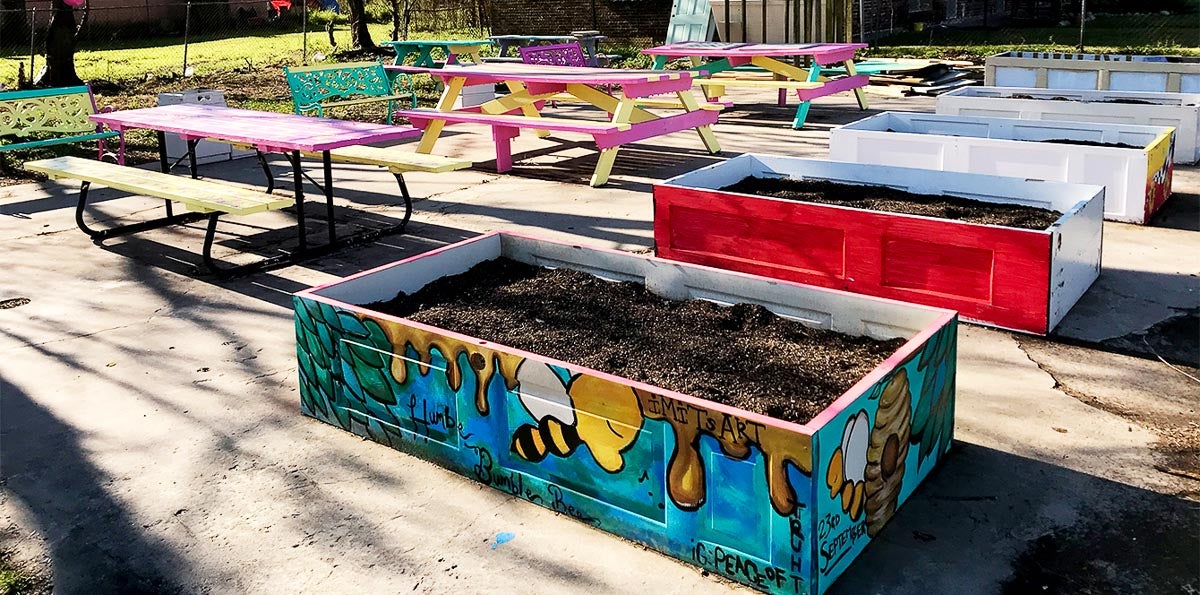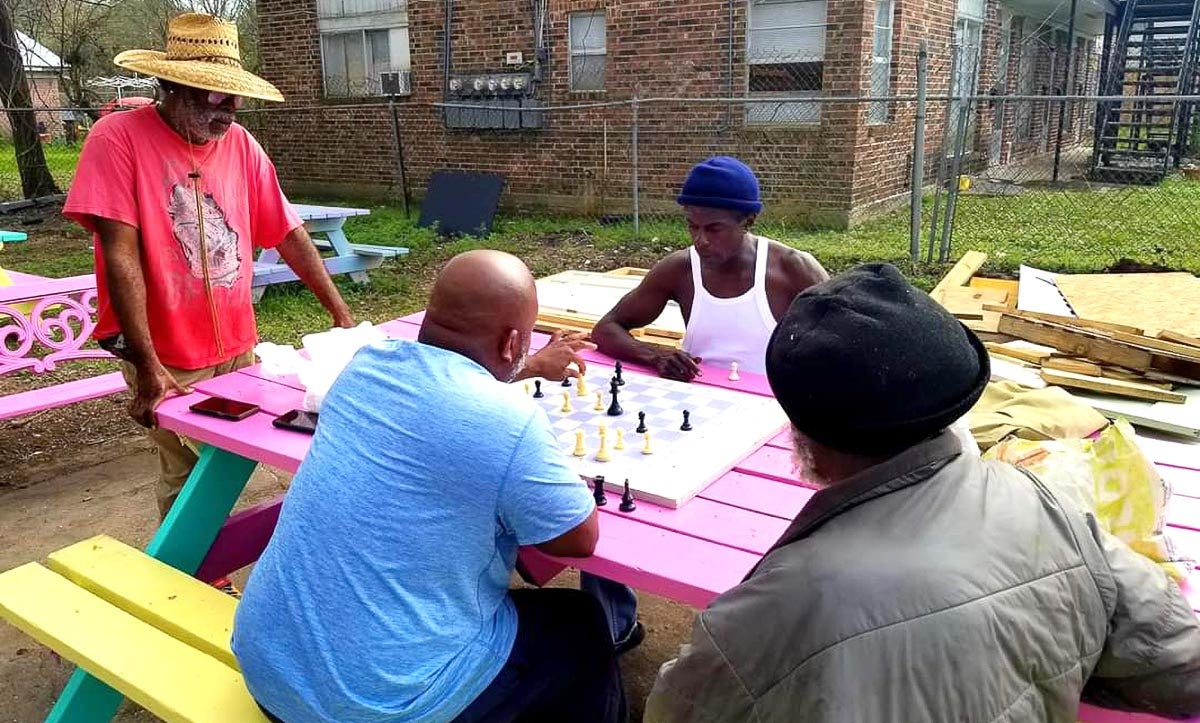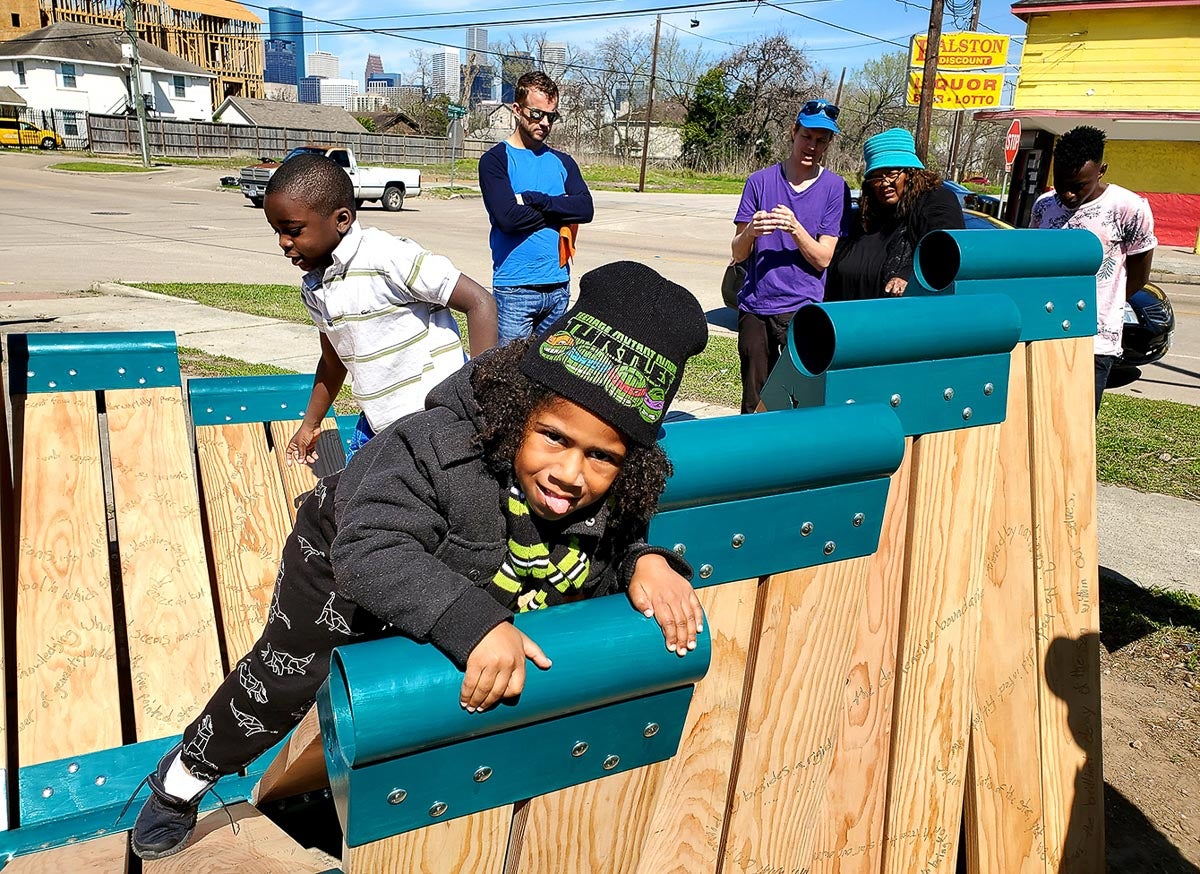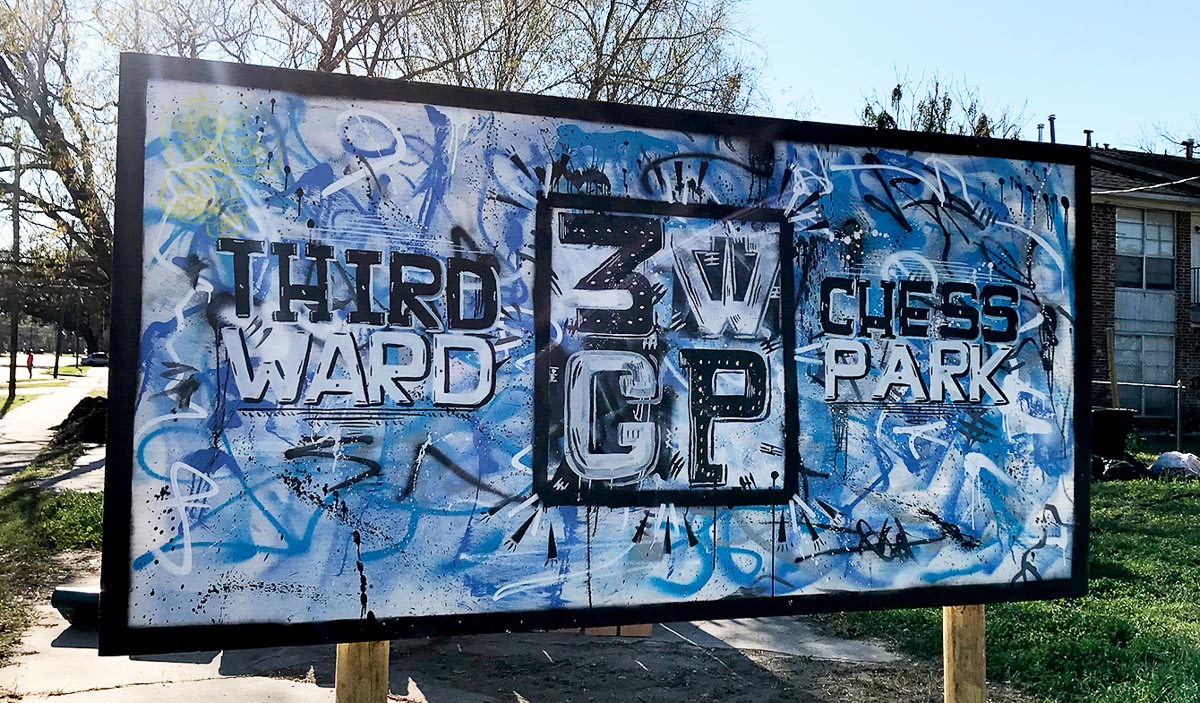When Ed Pettitt learned that the lot on the southwest corner of Sauer and Tuam streets in the Third Ward had been sold, he wasn’t surprised. For a couple of years, Pettitt, who lives nearby, occasionally would drop by the vacant property where people — mostly older men — in the neighborhood got together to play chess, dominoes, cards and socialize in the shade of a tallow tree.
“I’d stop to visit the gentlemen — more to watch since I’m not much of a chess player myself — and eventually I noticed that many of the surrounding lots with older bungalow homes started to be bought up and demolished,” he says. “Townhouse development moved closer with each passing month and we began discussing what would happen when they got pushed off the vacant lot.”
Pettitt knew someone would have to find a new home for the group — known as Third Ward Chess Club — to meet.

Picnic tables and benches were donated to the Third Ward Chess Park by Sparkle Hamburger Spot and Axelrad. Wooden doors contributed by Houston Reuse were turned into raised bed planters.
Photo by Andy Olin, Kinder Institute
Turning a vacant lot into a park
As it turns out, Pettitt was uniquely positioned to spearhead the chess club’s relocation. That’s because he leads the working group addressing issues related to parks and neighborhood character for Third Ward’s Complete Communities strategy.
Each of the 10 Complete Communities draws up an action plan defining a vision and the policies, goals and projects necessary to strengthen the community. In Third Ward, re-purposing vacant land for small pocket parks and plazas was identified as a tactic for developing new parks and public spaces — one of the high-priority goals in its action plan.
“The realization that this vacant lot may not be vacant much longer sparked an effort to identify a new space with better infrastructure to make a case for long-term investment,” Pettitt told KPRC for a story that ran in January, referring to the property at Sauer and Tuam.
Thanks to the hard work of Pettitt and others, the sale of the property turned out to be a blessing in disguise. A local real estate developer is letting the community use a piece of property at McGowen and Live Oak for the new Third Ward Chess Park, which opened in January.
Building a chess park is a lesson in tactical urbanism
The story of the chess park reads like a case study in the power of action at the hyperlocal level to create change that improves life in a community.
Demonstration projects such as this — in which a city, community or a group of enterprising and engaged residents target long-term goals using quickly executed, low-cost and provisional plans — are great examples of tactical urbanism. The intention is to go from “pop-up to permanent.” The interventions can be used for repurposing or reclaiming streets, sidewalks and public spaces to improve the safety, bikability, walkability and vitality of urban areas. Tactical urbanism is intended to guide and influence future decisions made by local agencies and policy-makers.
Pettitt found inspiration in the work of Dallas nonprofit Better Block. In particular, a project he read about on Facebook that employed crime prevention through environmental design — CPTED — to redesign and improve a dangerous intersection known as Five Points in Vickery Meadow, a high-crime neighborhood in North Dallas.
The facelift included repainting crosswalks in bright colors, the installation of additional lighting, adding planter boxes with trees and shrubs and transforming part of a parking lot into a public plaza.
Pettitt shared the article and asked if anyone to partner with him on a similar project in Third Ward. Ciara Jarmon, the local developer who owns the lot at McGowen and Live Oak, was interested. Crime and safety in the area where the chess park is located are a concern for many community members.
“The idea was to create more ‘eyes on the street’ from neighbors, while also beautifying and greening vacant space,” Pettitt says, “which research shows has an effect on reducing crime.”
It couldn’t have been done without a collective effort
Not long after Jarmon offered Pettitt the use of her land, he was at a Block Improvement Group meeting — an initiative of the Northern Third Ward Implementation Project at Change Happens — where he met Rich Johnson, who runs Cinque Projects, a Third Ward nonprofit that encourages and supports entrepreneurship in the neighborhood. Pettitt connected Johnson and Jarmon and began looking for in-kind donations and grants to build the chess park.
Picnic tables and benches donated from Sparkle Hamburger Spot and Axelrad have new homes at the park. Axelrad owner Adam Brackman also donated a bike rack and a pergola for the project. Wooden doors contributed by Houston Reuse were reborn as raised bed planters. And old hardhats from Houston Tool Bank were turned upside down and converted into hanging planters.
Over two days, volunteers from local churches, civic groups and student organizations helped clean up, prep and transform the lot. Members of the Third Ward Chess Club will handle the maintenance of the park with assistance from Cinque Projects.
According to Jarmon, the property owner, the Third Ward Chess Park serves as a test case for the city, which could purchase other lots in Third Ward for similar green-space conversions.
“Reclaiming incidental spaces like vacant lots for activation as green spaces and parks not only utilizes overlooked land but increases equitable access to nature and recreation,” Pettitt told KPRC.
“Our ultimate goal is for the Houston Parks and Recreation Department (HPARD) to see the value of such vacant-lot conversions,” Pettitt says, “particularly for ‘shade tree’ chess players who desire appropriate park space to play together. Unfortunately, past experience has shown us that HPARD and other city departments have a bureaucratic approach that doesn’t always meet residents’ needs. The chess tables at nearby Emancipation Park, for example, are interspersed around a children’s splash pad.”
Pettitt reports that the next project for the chess park is painting crosswalks at the intersection of McGowen and Live Oak. Though the intersection is a four-way stop, he says several cars “blow through the stop signs every hour.”
“We would like to paint the crosswalks in a chessboard pattern, in homage to the chess park,” Pettitt says. “We’ve contacted Houston Public Works and Houston Southeast Management District, but haven’t made much progress. If all else fails, we may be forced to put in temporary crosswalks in a tactical urbanism approach to spur a more permanent solution from the city or management district.”

A local real estate developer is letting the community use a piece of property at McGowen and Live Oak for the new Third Ward Chess Park.
Photo courtesy of Ed Pettitt
The chess park is similar to the work of the NYC Plaza Program
In the same spirit as the Third Ward Chess Park, New York’s Plaza Program converts underused city streets into public spaces where residents can gather. For streets selected for the program, there’s a three-step process that begins with a one-day plaza, then an interim plaza and finally a permanent plaza. The Plaza Program is overseen by the transportation department but is part of the citywide effort to make sure all New Yorkers live within a 10-minute walk of parks and open spaces.
This Wednesday, March 4, the Kinder Institute will welcome Mitchell J. Silver, the commissioner of the New York City Parks Department, to discuss how planning and design can create equitable, inclusive and fun places for residents in all cities. In his presentation, “Parks and Public Space: What’s Next?” Mitchell talks about the importance of thinking about public spaces — streets, sidewalks, bike lanes, parks and more — as parts of one system.
Examples of tactical urbanism in Houston and further reading:
Community Resilience Initiatives: Building Stronger Neighborhoods in Houston, a Kinder Institute report released in February, profiled the work of the Department of Transformation (DOTr) — a Near Northside-based organization dedicated to creating safe streets in Houston. DOTr is guided by the tenets of tactical urbanism, which blends community engagement and low-cost, unofficial interventions to make immediate improvements in the built environment.
Community members identified three intersections in the neighborhood where a tactical urbanism approach could be employed to effect change: Lorraine and Elysian, Hardy and Harrington and Fulton and Quitman.
Rather than wait for city officials to make changes at these intersections, DOTr members engaged the community and used tactical urbanism to take matters into their own hands. DOTr showed the community that even small changes can have a positive impact on street safety.
Gathering together families, children, community leaders and support from the Salvation Army, the group cleared away sidewalks that had been blocked by overgrowth for years, created a pop-up bike lane in partnership with BikeHouston and spray-painted crosswalks to ease pedestrian and car traffic.
Further reading …
This Gray Matters piece, which was written by employees of Houston landscape architecture, planning and urban design firm Asakura Robinson, examined parklets, the Sunday Streets program and a project to transform extra-wide streets in EaDo.
Urban planner Mike Lydon is recognized as person behind the concept of tactical urbanism as we know it today. His ideas have changed the way many think about how cities can be transformed. He has co-authored several guides to tactical urbanism.

The Third Ward Chess Park serves as a model for similar green-space conversions.
Photo courtesy of Ed Pettitt

